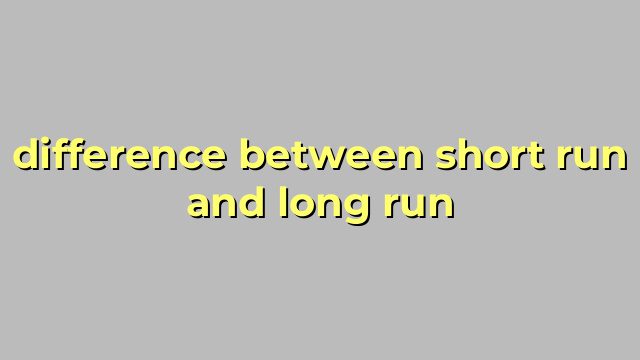The Basic Differences Between Short Run and Long Run
When it comes to economic theory, the concepts of short run and long run have significant implications. These terms refer to the length of time over which a business or economy can make adjustments to its operations. Understanding the differences between the two notions can help business owners, investors, and policymakers make more informed decisions about their financial decisions.
Short Run
The short run refers to a period during which the economy or business cannot adjust all its factors of production. In other words, in the short run, some inputs, typically capital or labour, are fixed, while others are variable. For example, a company may have a fixed number of workers in the short-term but can adjust its production processes or the amount of raw materials used.
In the short run, a business’s profitability may depend on factors such as production efficiency, market demand, input and output prices, and cost structure. However, companies face limits to how much they can alter these variables in a short period, as they are committed to their capital investments, workforce, or contracts. This means that businesses may have to operate at a loss or reduced profit margin in the short term, and may not be able to immediately respond to changing market conditions.
Long Run
The long run, on the other hand, is defined as the period during which a business or economy can adjust all its inputs. In this period, businesses are free to purchase or sell assets, adjust worker levels, and modify their business processes as necessary to respond to changing market conditions. Because there are fewer restrictions on their operations, businesses can achieve higher levels of profitability and economic growth in the long run.
In the long run, businesses can adjust their production processes, find new ways to reduce costs, and target new markets. For example, a technology company can invest in research and development, acquire new firms, or expand to new regions. Similarly, a manufacturer may build a new factory, purchase new machinery, or relocate to a region with lower costs of operations. These actions can help them enhance their competitive position and promote economic growth.
Conclusion
In conclusion, the differences between short run and long run play a significant role in shaping the growth and profitability of businesses and economies. While businesses may have limited control over their inputs in the short run, they can make changes over time to enhance their productivity and competitiveness. By contrast, the long run is characterized by greater flexibility and the ability to make significant investments that can drive economic growth. Businesses and policymakers should carefully consider the differences between the two periods when making financial and economic decisions.
Table difference between short run and long run
| Short run | Long run |
|---|---|
| Refers to a time period where at least one factor of production is fixed. | Refers to a time period in which all factors of production are variable. |
| Markets may not have enough time to adjust to changes in demand or supply. | Markets have enough time to adjust to changes in demand or supply. |
| Costs are partly fixed and partly variable. | All costs are variable. |
| Profit maximization may not be the objective of firms. | Profit maximization is the main objective of firms. |
| Productive capacity may be limited. | Productive capacity can be expanded or contracted as needed. |
| Output decisions are made based on existing equipment and facilities. | Output decisions are made based on new investments in equipment and facilities. |

